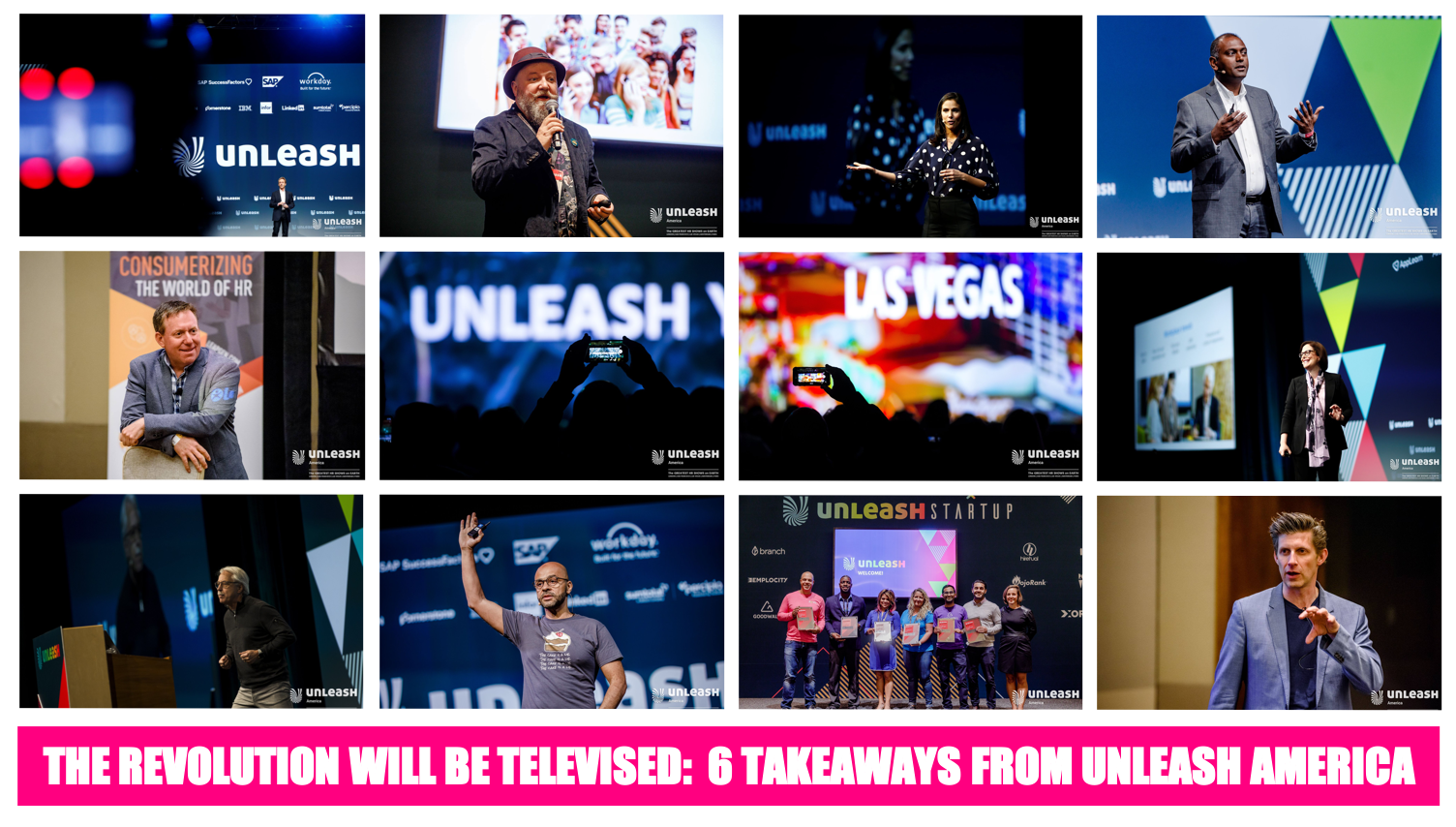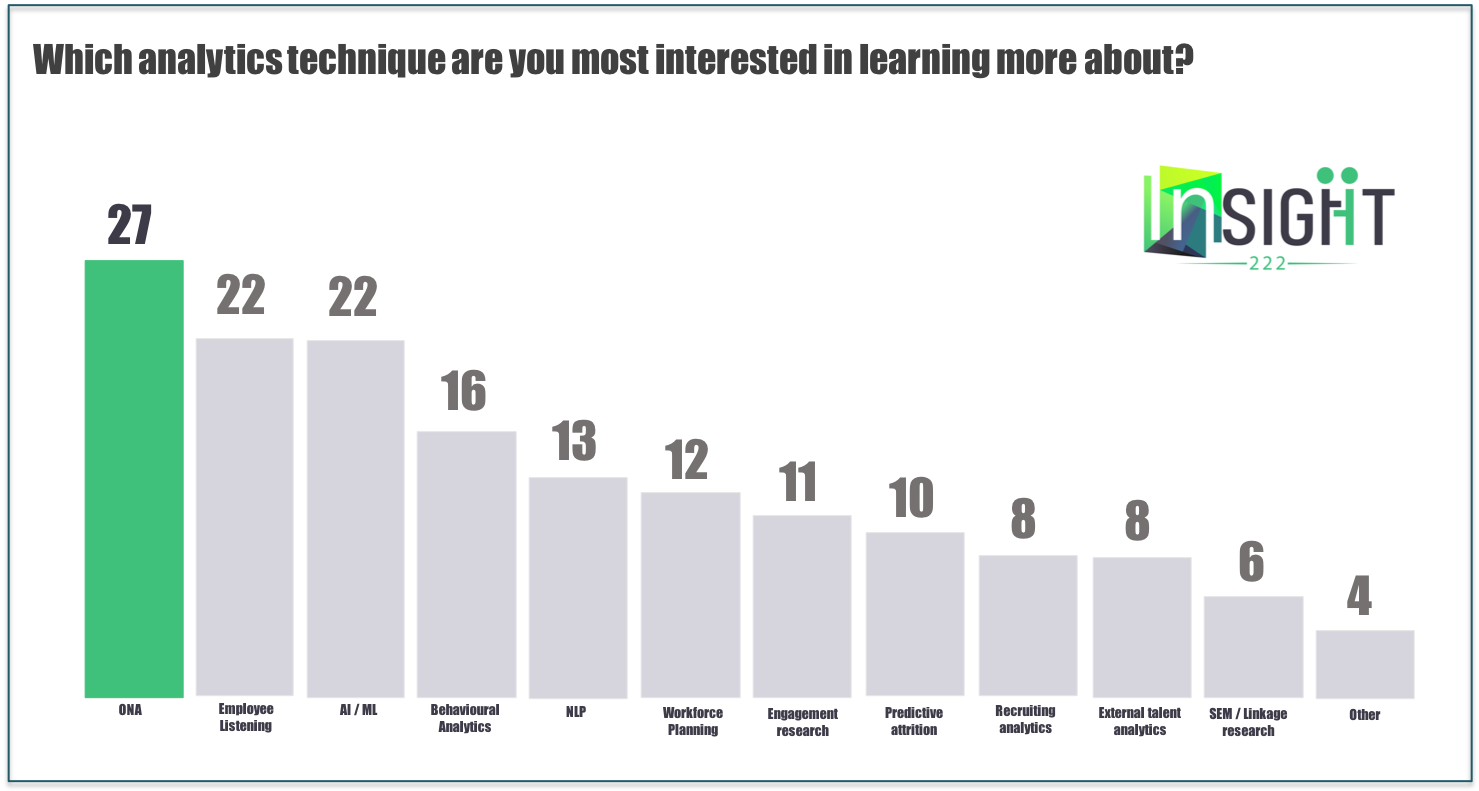In my latest article for UNLEASH, I outline seven steps to getting started in people analytics: Learn the business, focus on the business, answer the right questions, Expand your mind: read, learn, network and grow and Get your CHRO involved are the first three…
The revolution will be televised: six takeaways from UNLEASH America
The role of Organisational Network Analysis in People Analytics
One of the most exciting trends in people analytics is the rapid growth of Organisational Network Analysis (ONA), which whilst not new is witnessing a resurgence thanks to developments in technology, new ways of working and changing business requirements.
When I meet with people analytics leaders, ONA regularly crops up in the conversation as one of the techniques that they have either already begun to use or plan to deploy within their organisations.
Indeed, research conducted by Insight222 towards the end of 2017 (see Figure 1 below) found that ONA was the analytical technique that people analytics leaders most wanted to learn more about.
Figure 1: Organisational Network Analysis is the technique that HR & People Analytics leaders most want to learn more about (Source: Insight222)
The role of ONA in people analytics was the topic of my presentation at UNLEASH in Las Vegas on 15 May. The slides I used during my speech are included here. The purpose of this article is to answer the following questions I regularly get asked about ONA:
- What is ONA?
- Why is ONA growing in importance?
- What is ‘Active’ and ‘Passive’ ONA? Which one should we use? Can we use both?
- What can we use ONA for?
- What case studies on ONA are available?
- Where can I find out more about ONA?
WHAT IS ONA?
If you Google ‘Organisational Network Analysis’, you will uncover a lot of dry and technical descriptions of what ONA is, which are mostly a variation of “Organisational Network Analysis is a structured way to visualise how communications, information and decisions flow through an organisation” (which came from Deloitte).
I prefer Michael Arena’s description in his excellent recent podcast with Al Adamsen, where the Chief Talent Officer of GM defined ONA as providing “a new lens to evaluate how people show up in an organisation.
"ONA provides a new lens to evaluate how people show up in an organisation"
Similarly, in his article ‘What is ONA?’, Professor Rob Cross, arguably the world’s foremost expert on the subject, explains that “ONA can provide an x-ray into the inner workings of an organisation — a powerful means of making invisible patterns of information flow and collaboration in strategically important groups visible”. In the same article, Cross provides a perfect example to illustrate this viewpoint and how ONA enables you to see what is going on in a company.
Figure 2 - An example of the insights offered through ONA (Source: Rob Cross)
The example in Figure 2 is of an ONA project undertaken by Cross with the exploration and production division of a large petroleum organisation. It identifies mid-level managers critical to information flow such as Mitchell, who is the only point of contact between members of the production division and the rest of the network. It also highlights that the Senior Vice President Mares is peripheral to the network and is essentially an untapped and under-utilised resource, whilst the Production team is isolated and separated from the network. None of this is visible from the rickety old org chart.
Head over to LinkedIn to read the remainder of: The role of Organisational Network Analysis in People Analytics
People Analytics in Asia Pacific: Why is it different?
This is a co-authored article with Arun Sundar of TrustSphere.
The recent 2018 Global Human Capital Trends report from Deloitte highlighted the rising importance of people data and analytics to organisations in Asia Pacific. Figure 1 below highlights the top 10 trends in the APAC region, with People Data ranking as the fourth most important trend (it ranked second globally). The study shows that 89% of respondents (the global figure was 85%) believe that people data is important or very important, but that only 38% (42% globally) believe that their organisations are ready or very ready in this category.
Figure 1: The top 10 trends in the Asia Pacific region highlighted in Deloitte's 2018 Global Human Capital Trends report by importance and readiness (Source: Deloitte Global Human Capital Trends, 2018)
PEOPLE ANALYTICS IN ASIA PACIFIC FACES A UNIQUE SET OF CHALLENGES
From speaking to people in the HR Analytics community in Asia Pacific, it is clear that the challenges around building and sustaining capability with regards to people analytics are different to those in Europe and North America, and also vary considerably across a region that is home to 65% of the world's population.
This article, which is part of a series focused on people analytics in Asia Pacific that will be published during the course of 2018, explores the main differences. It is equally intended to provide guidance to global organisations with operations in the APAC region as well as Asia Pacific based organisations themselves seeking to capitalise on the many benefits – both to the business and employees – offered by people analytics and a more data-driven approach to HR.
CONTRIBUTORS
The series of articles is a collaboration with Arun Sundar, Chief Strategy Officer of TrustSphere, who as well as providing an explanation of the differences associated with practicing people analytics in Asia, will also invite comment from other experts in the people analytics community in the region. This article includes contributions from Nick Sutcliffe of The Conference Board, Jayesh Menon, HR Director of Moet Hennessy, Junko Owada of Hitachi and Alexis Saussinan from Merck. Arun and I would like to thank each of you for your invaluable contributions to this article.
To continue, head over to LinkedIn to read the remainder of People Analytics in Asia: Why is it different?
Three reasons I've joined Insight222 as a board advisor
Truly special opportunities come about maybe once in a lifetime. If you are able to fulfil your passion, work with exceptional people, and contribute to driving real change and progress in your chosen field then you simply must grab such an opportunity with both hands.
This is why I am so thrilled to be invited by Insight222 to become a Non-Executive Director (see announcement by Co-Founder and CEO, Jonathan Ferrar).
Here are three reasons why I took this opportunity:
1. ELEVATING PEOPLE ANALYTICS TO THE CENTRE OF BUSINESS
Insight222’s mission - To put People Analytics, as a discipline, at the centre of Business - aligns directly with my own raison d’être. We simply must make our workplaces more humane. In his new book, ‘Dying for a Paycheck’, Jeffrey Pfeffer, Professor of Organizational Behaviour at Stanford University provides a damning indictment on the 21st century workplace. Pfeffer provides evidence on how modern management practices propagate stress, diminish engagement, destroy the mental and physical health of employees, and ultimately damage company performance. This is why I believe that people analytics is so important as it can shine a light on the harm the practices highlighted by Pfeffer cause and provide actionable insights that drive organisational performance andemployee experience and wellbeing.
2. CREATED BY PEOPLE ANALYTICS AND HR LEADERS FOR PEOPLE ANALYTICS AND HR LEADERS
The People Analytics Program is the signature offering of Insight222’s strategy to realise its mission. The program combines tools, research, learning, expertise and consulting, and helps clients (namely Heads of People Analytics and CHROs, as well as HR professionals and practitioners) be successful in bringing increased value to their organisations. What makes Insight222 standout, and what makes it so compelling for me, is that the program is being delivered by people (see image below) who have been people analytics and HR leaders themselves. This means not only does Insight222 have a deep understanding of the challenges faced by people analytics leaders but is also able to design, facilitate and deliver solutions that can help leaders learn, create, explore and ultimately make better decisions and be more influential. Moreover, advising Insight222 will help me in my mission to play a role in developing the wider people analytics and entire global HR community and profession too.
3. MORE THAN JUST NETWORKING
Networking on its own is not enough. It’s one thing to meet up with your peers a few times a year and exchange a few emails. It’s quite another to actually do work with them. This is what makes Insight222 and The People Analytics Program so unique. Since launching in the second half of 2017, Insight222 has already signed up over 25 member organisations in Europe and North America. Together these represent some of the largest companies and most advanced people analytics teams in the world. Insight222 works with them to harness the collective intelligence in the group, identify common challenges and then facilitates the co-creation of initiatives to meet these needs. For example, the current co-creation project is to develop an Ethics Charter to answer the collective premise of “How might HR build trust that People Analytics work will benefit and not harm our employees, and still ensure business value and impact”.
FIND OUT MORE
If you are a people analytics leader and want to find out more about The People Analytics Program, explore the Insight222 website, watch the video below featuring Richard Rosenow(Facebook), Geetanjali Gamel (Merck & Co), Steffen Riesenbeck (Bosch), Michelle Deneau(Intuit) and Josh Bersin and/or get in touch with me at david.green@insight222.com.
This article was originally published on LinkedIn on 25th April 2018 - see here





